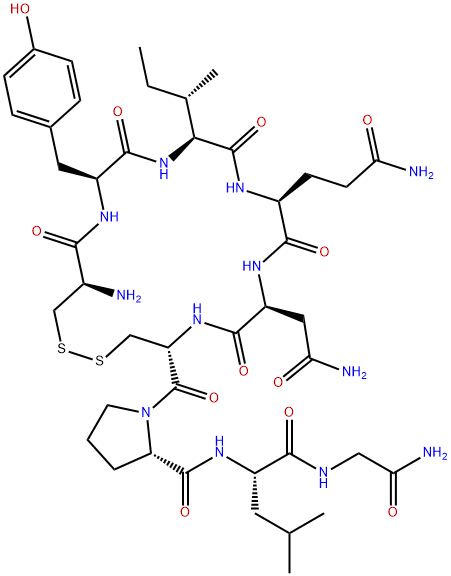PRODUCT Properties
| Melting point: | 192-194°C |
| alpha | D22 -26.2° (c = 0.53) |
| Boiling point: | 1533.3±65.0 °C(Predicted) |
| Density | 1.1086 (rough estimate) |
| refractive index | 1.6700 (estimate) |
| storage temp. | 2-8°C |
| solubility | Very soluble in water. It dissolves in dilute solutions of acetic acid and of ethanol (96 per cent). |
| form | lyophilized powder |
| pka | pKa ~6.1(free amino group on Cys) (Occasionally);~10(free phenol on Tyr) (Occasionally) |
| color | White |
| optical activity | -26.222 (H2O) |
| biological source | synthetic (organic) |
| Water Solubility | Soluble in water. |
| Merck | 13,7049 |
| BRN | 3586108 |
| InChIKey | DSZOEVVLZMNAEH-BXUJZNQYSA-N |
| CAS DataBase Reference | 50-56-6(CAS DataBase Reference) |
Description and Uses
Oxytocin is a peptide hormone containing nine amino acids secreted and synthesized by the paraventricular and supraoptic nuclei of the hypothalamus and stored and released by the neurohypophysis. It acts in females by inducing uterine contractions during parturition and stimulating milk ejection by the mammary glands. No actions in males are known. Synthetic derivatives of oxytocin are used to induce labor and for therapeutic abortions. In recent years the safety of oxytocin has been greatly enhanced by the use of continuous maternal and fetal monitoring and by the use of controlled intravenous infusion of the drug.
Oxytocin is used as a peptide hormone that acts predominantly as a neurotransmitter; stimulates uterine contraction and lactation, increases Na+ excretion; stimulates myometrial GTPase and phospholipase C.
Safety
| Symbol(GHS) |   GHS06,GHS08 |
| Signal word | Warning |
| Hazard statements | H300-H361 |
| Precautionary statements | P201-P280-P301+P310a-P308+P313-P405-P501a |
| Hazard Codes | Xi |
| Risk Statements | 36/37/38 |
| Safety Statements | 26-36 |
| RIDADR | 3249 |
| WGK Germany | 3 |
| RTECS | RS7534000 |
| F | 3-8-10-23 |
| HazardClass | 6.1(a) |
| PackingGroup | II |
| HS Code | 2937190000 |
| Hazardous Substances Data | 50-56-6(Hazardous Substances Data) |
| Toxicity | LD50 oral in rat: > 20520ug/kg |





